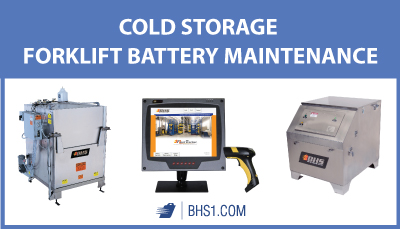We use cookies to make your experience better. To comply with the new e-Privacy directive, we need to ask for your consent to set the cookies. Learn more.
Cold Storage Forklift Battery Maintenance
Cold storage is hard on lift truck batteries. Poor inventory management and maintenance is even worse. The combination of an extreme environment and shortcuts in battery handling practices can cause major reductions in battery capacity and lifespan. That's why it's important to use best practices for forklift batteries in cold storage applications. Here's what you need to know to keep your batteries running at peak condition for as long as possible, even in refrigerated warehouses:
- Extreme cold temperatures reduce forklift battery capacities.
- Optimizing battery management in cold storage applications is crucial to preserving a battery's capacity.
- Cold storage facilities face the same maintenance challenges as ambient warehouses.
In fact, forklifts may have their runtimes reduced by more than 50 percent in cold climates. This leaves cold storage facilities with a number of problems that other warehouses or distribution centers never face.
For instance, in an ambient setting, a battery may last an entire eight-hour shift, making an end-of-shift change-out a matter of common sense. In a cold storage environment, a battery may last just 6 hours, which makes scheduling the changeout tricky. Operations may be tempted to swap out batteries halfway through a shift for convenience. However, experts recommend running each battery until it's fully depleted to maintain its capacity over time.
However, a surprising number of businesses forgo best practices in favor of convenience. “In ambient environments, probably 90% of customers have well-managed battery inventories,” Brian Faust, general manager for Douglas Battery, told Modern Materials Handling. “When they try to adapt those same practices to cold areas, it doesn’t work. They end up needing more batteries and struggle as the worker’s rhythm is disrupted. Probably 50% of customers in cold storage have it managed correctly.”
Faust says the two most common offenses in cold storage environments are not fully depleting batteries and not fully charging and cooling off batteries. By adjusting battery management to workers' schedules, these companies risk ever-shortening battery capacities, which inevitably necessitates purchasing new batteries. Instead, workers should adjust to optimal change-out times for the battery (which can be made easier with Battery Fleet Management technology).

The most important maintenance task is washing batteries. Over time, corrosive electrolyte builds up on batteries and acts as a conductor, causing a continuous low-level discharge. Battery acid can also damage terminals and shorten battery life while causing electrical damage to forklifts.
For these reasons, operations must occasionally take batteries out of circulation to wash them. A good way to reduce downtime is by having Battery Wash Stations on site. Staff can safely clean batteries while containing wastewater in a walled unit. Fully contained Battery Wash Cabinets automate the entire process while Recirculation/Neutralization Systems or Wastewater Recycling Systems create closed loops for reusing wastewater.
Another crucial maintenance task is watering batteries after they are charged. By using ergonomic Watering Guns with automatic shutoffs, you're guaranteed not to overwater a battery. Accidental overwatering can result in boilovers, which reduce a battery's capacity — a mistake cold storage facilities can ill afford.
By keeping up with maintenance tasks, cold storage facilities can be sure that they aren't losing any more battery capacity than the extreme temperatures demand. These operations face unique challenges, but smart management and dependable maintenance help overcome them.
References
Bond, Josh. "Lift Truck Tips: Batteries Take More Heat in Cold Storage." Modern Materials Handling. 1 Nov. 2014. 18 Mar. 2018.
Rogers, Laurie. "Best practices for Managing a Cold Storage Warehouse." Modern Materials Handling. 1 Jan. 2012. 18 Mar. 2018.
